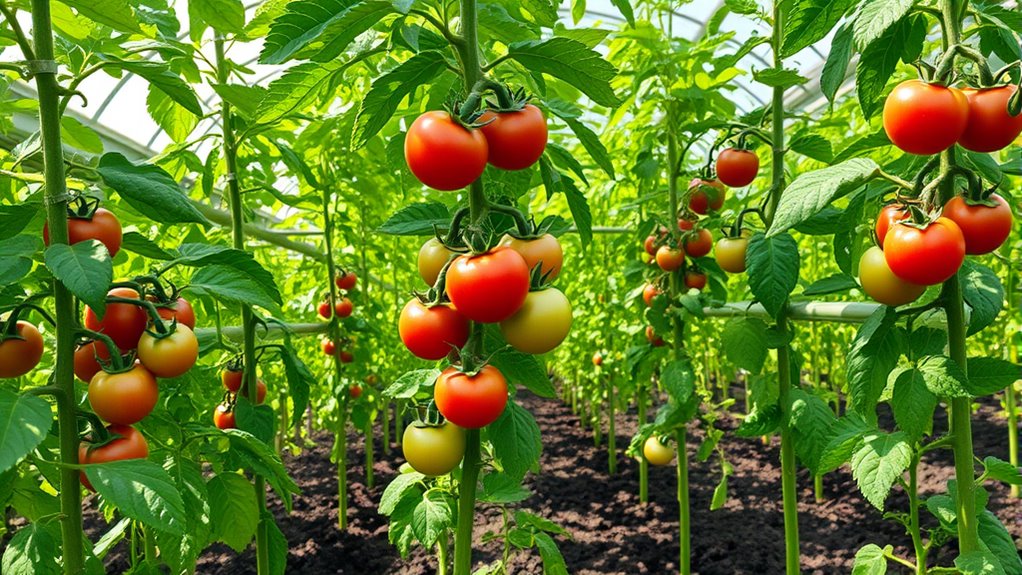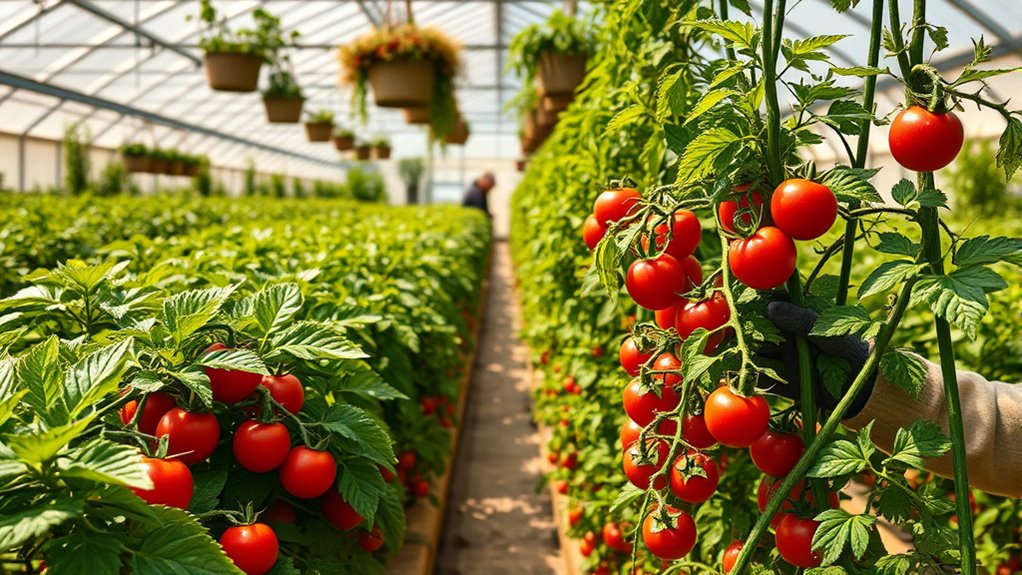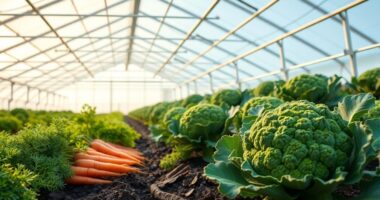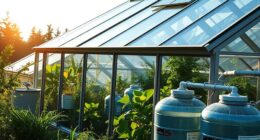To grow tomatoes successfully in a greenhouse, inspect plants regularly for pests like aphids and whiteflies, and use organic controls and good sanitation to prevent infestations. Maintain consistent watering with drip systems or soaker hoses, keeping soil moist but not soggy, and mulch to preserve moisture. Control environmental factors by ensuring proper ventilation and avoiding excessive heat or humidity, while removing diseased foliage promptly. Focus on healthy nutrition and hydration—continue to explore expert tips for boosting your harvest even further.
Key Takeaways
- Maintain optimal environmental conditions with proper ventilation, temperature, and humidity control to promote healthy tomato growth.
- Use consistent watering techniques like drip irrigation, and mulch to ensure proper soil moisture and root health.
- Regularly inspect plants for pests and diseases; employ integrated pest management and keep the greenhouse clean.
- Use physical barriers like fine mesh screens to prevent pest entry and disease spread.
- Remove diseased foliage promptly and keep the greenhouse sanitized to support a healthy, bountiful harvest.

Growing tomatoes in a greenhouse gives you control over the environment, allowing for better yields and extended growing seasons. To make the most of this setup, you need to focus on effective pest management and watering techniques. Pest problems can quickly ruin your crop if not addressed early. Regularly inspect your plants for signs of pests like aphids, whiteflies, or spider mites. Use integrated pest management strategies, such as introducing beneficial insects or applying organic insecticides, to keep pests at bay without harming your plants. Keeping your greenhouse clean and removing any diseased or infested foliage also helps prevent pest outbreaks. Covering vulnerable plants with fine mesh screens can block pests from entering, especially when you’re introducing new plants or seedlings. Proper sanitation and monitoring are crucial for maintaining a healthy crop and minimizing chemical use.
Watering techniques play a vital role in healthy tomato growth. Tomatoes prefer consistent moisture, but overwatering can lead to root rot and other diseases, while underwatering stresses the plants, reducing fruit production. To avoid these issues, implement a watering schedule that maintains even soil moisture. Using drip irrigation systems or soaker hoses allows you to water directly at the roots, minimizing water waste and reducing the risk of fungal diseases caused by wet foliage. Check the soil regularly with your finger or a moisture meter; it should feel moist but not soggy. Mulching around the base of your plants helps retain soil moisture, regulate temperature, and suppress weeds, which compete for nutrients and water. Additionally, understanding the importance of hydration and nutrition can significantly influence plant health and productivity.
Temperature and humidity control also support your watering and pest management efforts. Keep the greenhouse well-ventilated to prevent excess humidity, which can foster fungal diseases and attract pests. During hot days, use shade cloths or vents to prevent overheating, which can cause stress and make plants more susceptible to pests. Maintaining a stable environment helps your plants grow strong and reduces the need for chemical interventions.
Frequently Asked Questions
What Are the Best Tomato Varieties for Greenhouse Cultivation?
You should choose determinate varieties like ‘Tiny Tim’ or ‘Red Cherry’ for greenhouse growth. These have excellent tomato flavor profiles and produce compact plants, ideal for limited space. Organic tomatoes often offer richer flavors, but hybrid varieties like ‘Sun Gold’ balance flavor and disease resistance. Select based on your flavor preferences and whether you prioritize organic or hybrid types for a successful, flavorful harvest.
How Do I Prevent Pests in a Greenhouse Tomato Setup?
Think of your greenhouse as a fortress, shielding your tomatoes from pests. To prevent pests, choose pest-resistant varieties and maintain a clean environment. Regularly inspect plants for early signs of trouble, and use natural pest control methods like introducing beneficial insects or organic sprays. Keeping your greenhouse tidy and monitoring closely creates a strong barrier, ensuring your tomato bounty stays healthy and pest-free.
What’s the Ideal Temperature Range for Greenhouse Tomatoes?
You should keep your greenhouse tomatoes at an ideal temperature range of 70-85°F during the day and around 55-70°F at night. Maintain proper soil moisture to support healthy growth, and use effective pollination techniques like gentle shaking or hand pollination to guarantee fruit development. Keeping temperatures stable helps prevent stress, while consistent soil moisture and proper pollination boost your chances of a bountiful harvest.
How Often Should I Water My Greenhouse Tomatoes?
Think of your greenhouse tomatoes as dancers needing just the right rhythm. You should water them when soil moisture management indicates the top inch feels dry—typically every 2-3 days. Avoid overwatering, which can drown roots, or underwatering, which stresses plants. Adjust watering frequency based on weather, container size, and soil type. Consistent, moderate watering keeps your tomatoes thriving, ensuring they grow strong and produce a bountiful harvest.
Can I Grow Tomatoes Year-Round in a Greenhouse?
Yes, you can grow tomatoes year-round in a greenhouse. With proper season extension techniques, like heating and supplemental lighting, you create an ideal environment for indoor planting regardless of outside weather. This allows you to enjoy fresh tomatoes throughout the year. Just guarantee consistent watering, ventilation, and pest management to maintain healthy plants and maximize your harvest, no matter the season outside.
Conclusion
Think of your greenhouse as a nurturing cradle for your tomatoes, where each careful step you take plants the seeds of abundance. With patience and attention, you’re cultivating not just fruit, but a symbol of your dedication and growth. As your tomatoes ripen, they mirror your efforts—reaching toward the sun, thriving in the warmth of your care. Remember, a bountiful harvest reflects the love and effort you’ve invested, turning your greenhouse into a garden of possibilities.









